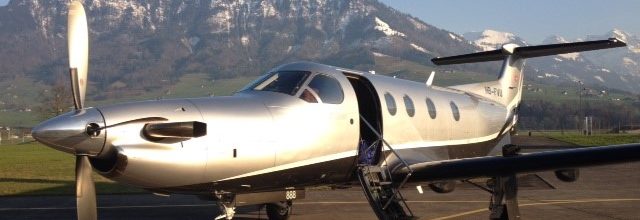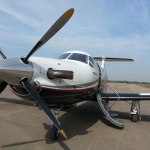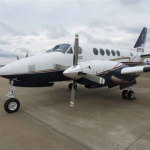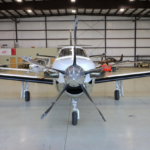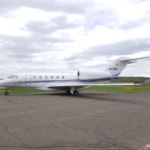Pilatus Aircraft Limited, based at Stans, in Switzerland, has produced a wide range of aircraft since forming in 1939. The company originally was best known for its training aircraft, the P-2 and P-3 (no longer in production), the PC-7 and PC-9. It also had success with the PC-6 Porter. The PC-6 production line was terminated in 2000, but continuing demand has seen the aircraft put back into production. The PC-21 is the latest trainer to be developed and started full production in 2008.
The product for which the Pilatus company is now best known for is the PC-12. This aircraft is revolutionizing the military, aeromedical, police and business aircraft market segments. Originally, the PC-12 was designed to compete with the Beech King Air B200. Both aircraft have similar size and performance, but the similarities end there. The most radical decision Pilatus made was to configure the aircraft with a single Pratt & Whitney PT6A-67B engine. They reasoned that with the technology and safety record of today’s modern turbine engines there was no need to carry around a spare engine, that resulted in a loss of payload and an exponential increase in costs.
The designers then focused on the cabin size and layout. The PC-12 designers added extra width to the cabin, making it more spacious and versatile than its competitors. Instead of a rear door for passenger access, they designed a forward air stair door for the passengers, and a large cargo door at the rear for freight. To facilitate freight loading and unloading, the cabin was designed with a completely flat floor and a constant cross section, with no interior bulkheads aft of the cockpit divider.
The cabin has numerous configuration options, depending on the operator’s mission requirements. There is a standard 6 or 8 seat executive configuration in addition to a high density option for commercial transport. The cabin can also be outfitted for air ambulance, surveillance and search and rescue, thereby increasing its potential customer base. Like most OEM’s, Pilatus made numerous upgrades to the original model. The first model designator change came in 1996/ 97 when, starting with msn 141, the Maximum Takeoff Weight(MTOW) was increased from 4100kg to 4500kg. These aircraft were designated PC-12/ 45. The next designator change came in 2006 when a number of modifications were introduced including:
- Increased MTOW to 4740kg
- PC-21 Style Winglet
- Redesigned Crew Seats
- New LED Cabin Lighting for Executive Interiors
- Reduced Roll Control Forces
- LED Navigation Lighting System
The designator was changed to PC-12/ 47 starting with msn 684. The biggest model change came in 2008 with the introduction of the PC-12 NG (Next Generation). This model featured a fully integrated Honeywell Primus Apex avionics system with four large displays, including two primary flight displays (PFDs) and two multi-functional displays (MFDs). These displays integrated flight information, engine monitoring, aircraft configuration, pressurization, and environmental controls not to mention flight and weather data, charts, aircraft system information, and trip planning functions. The aircraft was given more performance through the Pratt & Whitney Canada PT6A-67P engine, which delivers 15 % more thermodynamic power then the 67B for faster climbs and higher cruise speeds by utilizing single crystal CT blades and a new compressor configuration. Finally, they added a digital dual-zone Environmental Control System for increased cockpit and cabin comfort, a fully automatic digital Cabin Pressurization Control System which requires no input from the pilot, and a fully redundant Power Generation and Distribution System. The NG aircraft start at msn 1000.
There were additional upgrades to the NG. In 2010 they added a Cursor Control Device(CCD) for making selections on the two MFD’s. In 2011 they added the Build 7 software for the Apex suite which allowed for coupled vertical navigation capability (VNAV) as well as options such as Enhanced Vision System (EVS). In 2012, Build 8.3.2 software change provided Smartview Synthetic Vision as an option, the ability to use all four types of ground deicing fluids (Types I, II, III or IV) as well as numerous PFD and MFD display changes.

